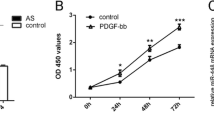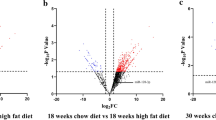Abstract
The proliferation, migration, and cellular morphology of vascular smooth muscle cells (VSMCs) play important roles in the pathogenesis of atherosclerosis (AS). Homocysteine (Hcy) is a sulfur-containing amino acid, which is an intermediate product of methionine metabolism. Hcy can induce proliferation, migration, and phenotypic switch of VSMCs, but details of these mechanisms are still unclear. The phosphatidylinositol 3-kinase (PI3K/Akt/mTOR) signaling pathway is involved in a host of cellular functions. In this study, we sought to determine if this multifunctional pathway played a role in Hcy-induced proliferation, migration, and phenotypic transformation of VSMCs, which has not been previously reported. miR-145 has been previously reported to suppress the effects of Hcy in VSMCs. In our study, using qRT-PCR, we found that Hcy itself reduced the expression of miR-145 in VSMCs, while overexpression of miR-145 reduced the proliferation, migration, and phenotypic transformation of VSMCs caused by Hcy. Using Western blot analysis, we found that VSMCs exposed to Hcy exhibited significant increases in the levels of PI3K, Akt, and mTOR proteins. Additionally, overexpression of miR-145 dramatically decreased PI3K, Akt, and mTOR expression. Using qRT-PCR we found that miR-145 expression increased after blocking PI3K using an inhibitor. Inhibition of the PI3K signaling pathway also prevented Hcy-induced VSMC proliferation, migration, and phenotypic switch. Taken together, our results suggest that miR-145 could inhibit VSMC proliferation, migration, and phenotype switching by preventing activation of the PI3K/Akt/mTOR signaling pathway.




Similar content being viewed by others
References
Allahverdian S, Chehroudi AC, McManus BM et al (2014) Contribution of intimal smooth muscle cells to cholesterol accumulation and macrophage-like cells in human atherosclerosis. Circulation 129:1551–1559
Amato RJ, Jac J, Giessinger S et al (2009) A phase 2 study with a daily regimen of the oral mTOR inhibitor RAD001 (everolimus) in patients with metastatic clear cell renal cell cancer. Cancer 115:2438–2446
An Y-M, Feng H, Zhang X-Z et al (2017) Homocysteine ameliorates the endothelium-independent hypoxic vasoconstriction via the suppression of phosphatidylinositol 3-kinase/Akt pathway in porcine coronary arteries. Biochem Biophys Res Commun 486:178–183
Basatemur GL, Jørgensen HF, Clarke MCH et al (2019) Vascular smooth muscle cells in atherosclerosis. Nat Rev Cardiol 16:727–744
Caruso P, Dempsie Y, Stevens HC et al (2012) A role for miR-145 in pulmonary arterial hypertension: evidence from mouse models and patient samples. Circ Res 111:290–300
Chan S, Scheulen ME, Johnston S et al (2005) Phase II study of temsirolimus (CCI-779), a novel inhibitor of mTOR, in heavily pretreated patients with locally advanced or metastatic breast cancer. J Clin Oncol 23:5314–5322
Chen C-Z, Li L, Lodish HF et al (2004) MicroRNAs modulate hematopoietic lineage differentiation. Science 303:83–86
Chen M, Zhang Y, Li W et al (2018) MicroRNA-145 alleviates high glucose-induced proliferation and migration of vascular smooth muscle cells through targeting ROCK1. Biomed Pharmacother 99:81–86
Cheng AM, Byrom MW, Shelton J et al (2005) Antisense inhibition of human miRNAs and indications for an involvement of miRNA in cell growth and apoptosis. Nucleic Acids Res 33:1290–1297
Cheng Y, Liu X, Yang J et al (2009) MicroRNA-145, a novel smooth muscle cell phenotypic marker and modulator, controls vascular neointimal lesion formation. Circ Res 105:158–166
Cordes KR, Sheehy NT, White MP et al (2009) miR-145 and miR-143 regulate smooth muscle cell fate and plasticity. Nature 460:705–710
Feil S, Fehrenbacher B, Lukowski R et al (2014) Transdifferentiation of vascular smooth muscle cells to macrophage-like cells during atherogenesis. Circ Res 115:662–667
Gao S, Xu L, Zhang Y et al (2018) Salusin-α inhibits proliferation and migration of vascular smooth muscle cell via Akt/mTOR signaling. Cell Physiol Biochem 50:1740–1753
Guo X, Li D, Chen M et al (2016) miRNA-145 inhibits VSMC proliferation by targeting CD40. Sci Rep 6:35302
Han X, Zhong Z, Kou J et al (2018) ROS generated by upconversion nanoparticle-mediated photodynamic therapy induces autophagy via PI3K/AKT/ mTOR signaling pathway in M1 peritoneal macrophage. Cell Physiol Biochem 48:1616–1627
Hutcheson R, Terry R, Chaplin J et al (2013) MicroRNA-145 restores contractile vascular smooth muscle phenotype and coronary collateral growth in the metabolic syndrome. Arterioscler Thromb Vasc Biol 33:727–736
Ji R, Cheng Y, Yue J et al (2007) MicroRNA expression signature and antisense-mediated depletion reveal an essential role of microRNA in vascular neointimal lesion formation. Circ Res 100:1579–1588
Li B, Ding CM, Li YX et al (2018) MicroRNA-145 inhibits migration and induces apoptosis in human non-small cell lung cancer cells through regulation of the EGFR/PI3K/AKT signaling pathway. Oncol Rep 40:2944–2954
Liao J, Zhang Y, Wu Y et al (2018) Akt modulation by miR-145 during exercise-induced VSMC phenotypic switching in hypertension. Life Sci 199:71–79
Lin H, Ni T, Zhang J et al (2018) Knockdown of Herp alleviates hyperhomocysteinemia mediated atherosclerosis through the inhibition of vascular smooth muscle cell phenotype switching. Int J Cardiol 269:242–249
Selhub J, Jacques PF, Bostom AG, D'Agostino RB, Wilson PW, Belanger AJ et al (1995) Association between plasma homocysteine concentrations and extracranial carotid artery stenosis. N Engl J Med 332:286–291
Shankman LS, Gomez D, Cherepanova OA et al (2015) KLF4-dependent phenotypic modulation of smooth muscle cells has a key role in athero-sclerotic plaque pathogenesis. Nat Med 21(6):628–637
Tang Y, Yu S, Liu Y et al (2017) MicroRNA-124 controls human vascular smooth muscle cell phenotypic switch via Sp1. Am J Physiol Heart Circ Physiol 313:H641–H649
Torella D, Iaconetti C, Tarallo R et al (2018) miRNA regulation of the hyperproliferative phenotype of vascular smooth muscle cells in diabetes. Diabetes 67:2554–2568
Weinert S, Poitz DM, Auffermann-Gretzinger S et al (2013) The lysosomal transfer of LDL/cholesterol from macrophages into vascular smooth muscle cells induces their phenotypic alteration. Cardiovasc Res 97:544–552
Xu P, Guo M, Hay BA (2004) MicroRNAs and the regulation of cell death. Trends Genet 20:617–624
Zhang C (2008) MicroRNomics: a newly emerging approach for disease biology. Physiol. Genom 33:139–147
Zhang D, Chen Y, Xie X et al (2012) Homocysteine activates vascular smooth muscle cells by DNA demethylation of platelet-derived growth factor in endothelial cells. J Mol Cell Cardiol 53:487–496
Zhang Y-N, Xie B-D, Sun L et al (2016) Phenotypic switching of vascular smooth muscle cells in the 'normal region' of aorta from atherosclerosis patients is regulated by miR-145. J Cell Mol Med 20:1049–1061
Zhou K, Fan YD, Wu PF et al (2017) MicroRNA-145 inhibits the activation of the mTOR signaling pathway to suppress the proliferation and invasion of invasive pituitary adenoma cells by targeting AKT3 in vivo and in vitro. Onco Targets Ther 10:1625–1635
Acknowledgements
Thanks to Xi'an Jiaotong University, Ningxia Medical University and the fund Ningxia High School first-class Disciplines (West China first-class Disciplines Basic Medical Sciences at Ningxia Medical University) NXYLXK2017B07, (Natural Science Foundation of Ningxia Province) 2019AAC03081 and National Natural Science Foundation of China (No. 81770459 and No. 81873520).
Author information
Authors and Affiliations
Corresponding author
Ethics declarations
Conflict of interest
The authors declare that they have no conflicts of interest.
Ethical approval
All studies were completed with the approval of the ethics review committee.
Additional information
Publisher's Note
Springer Nature remains neutral with regard to jurisdictional claims in published maps and institutional affiliations.
Electronic supplementary material
Below is the link to the electronic supplementary material.
Rights and permissions
About this article
Cite this article
Zhang, M., Li, F., Wang, X. et al. MiR-145 alleviates Hcy-induced VSMC proliferation, migration, and phenotypic switch through repression of the PI3K/Akt/mTOR pathway. Histochem Cell Biol 153, 357–366 (2020). https://doi.org/10.1007/s00418-020-01847-z
Accepted:
Published:
Issue Date:
DOI: https://doi.org/10.1007/s00418-020-01847-z




